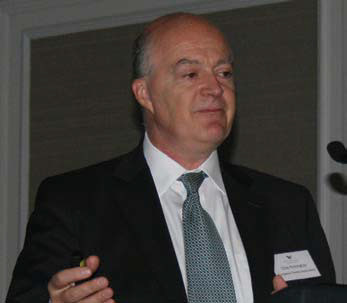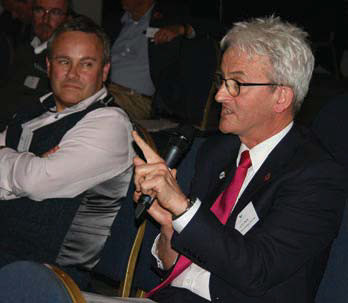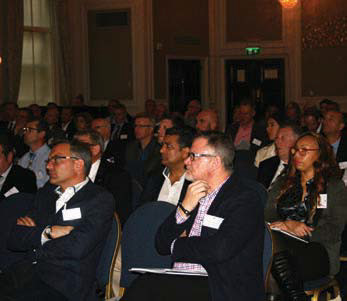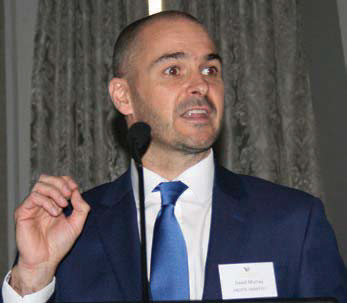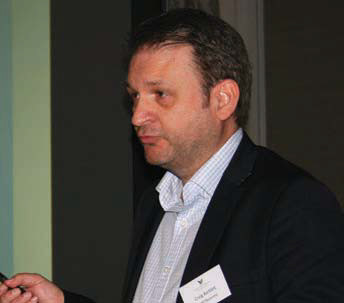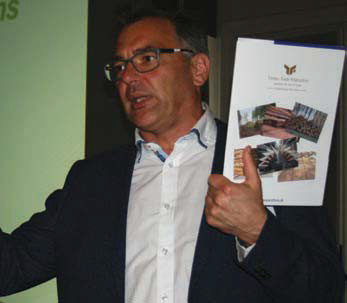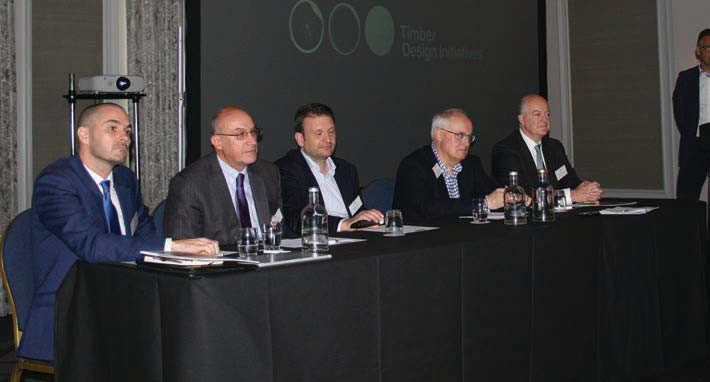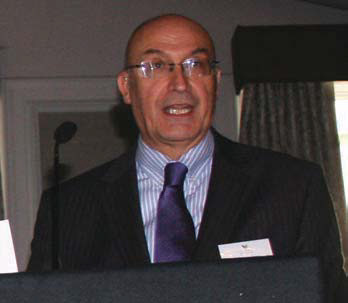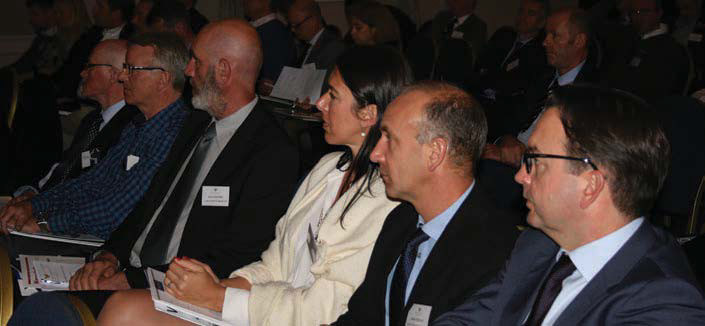Panel discussions
7 February 2019Sally Spencer of sister magazine, TTJ, reports from the UK Timber Trade Federation's(TTF) first UK Wood panels Conference which took place in London in November
The Timber Trade Federation’s (TTF) inaugural UK Wood Panels conference took place at the Grand Connaught Rooms in London on November 7, 2018.
The half-day conference, which the TTF hopes to build upon next year, was intended to bring the federation’s National Panel Products Division more in line with its National Softwood Division and National Hardwood Division, both of which already have their own events.
The panels’ conference was attended by manufacturers and distributors from both the UK and abroad and supported TTF managing director Dave Hopkins’ assertion that the panel sector “is the fastest growing and most innovative sector” within the timber industry.
“The UK is a very important market for panels from all over the world,” he said. “Innovation in the production and manufacture of panels for specific purposes is what gives them an advantage in the market. We want to make sure we run and lead that agenda.”
Clive Pinnington, managing director of the European Panel Federation (EPF) provided the market context, saying that, while the £22bn turnover of the 5,000 company-strong panels sector in Europe was seen as relative “peanuts” by the EU, the 100,000 jobs it accounted for really grabbed its attention.
Mr Pinnington said that panel output in Europe in 2017 was close to 60 million m2, 54% of which was particleboard (21% MDF, 10% OSB).
“Last year was a good year, with output up 3% across all panel types,” he said. Within that, hardboard had “suffered” and was actually down 3% but particleboard was up 2.7%, MDF 1.5% and OSB 3.3%. The star performers were softboard, which was up 6.9%, and plywood, which “surprised” everyone with a 7.8% rise in output.
Mr Pinnington said that while the industry still had some way to go until it regained its 2007 peak, the trend was in the right direction. He also said that significant production had shifted east to Russia and neighbouring countries during the recession and that this output was not covered by the EPF and therefore not factored in.
Five-year growth in wood based panel production within the EU-28 had outpaced GDP in those countries to the tune of +2.3% versus +1.8%. Clear proof, he said, that panels were gaining market share.
Mr Pinnington also outlined some of the EPF’s lobbying activities and priorities in 2018. He said that panels’ benefits were increasingly recognised and ticked many of the current 'buzzword' boxes.
They provide a model of the circular economy, for example, with more than 50% of their raw material derived from industrial by-products or recovered wood and the sector advocates the cascaded use of wood.
The EPF is also working hard to safeguard the industry against sectors that compete for raw material, such as bioenergy. “We advocate finding a way for both sectors to benefit and for no undue distortion of the raw materials market,” said Mr Pinnington, adding that subsidies for bioenergy should be for the hardware, not for the wood resource.
“We are central to the prevention of climate change,” he added. “Harvested wood products are recognised in the [United Nations’] Land Use, Land-Use Change and Forestry (LULUCF) and the European Commission’s recently published Bioeconomy Strategy cites the use of wood to reduce CO2 as early as page two. Timber is seen as an agent against climate change.
“We want people to think of us as the guys who re-use the wood, not the ones who destroy forests,” said Mr Pinnington.
“Cornerstone” areas of focus for the EPF going forward include increasing the use of panel products in construction, as this is where the most growth potential is identified. “We think CLT is marvellous, but we need to ride that wave together and get more wood based panels in construction.”
Focus will also be on working with African producers to ensure they can comply with European regulations, opening the door to trade; and on the E1 European emissions standard.
“With formaldehyde, we have to consider workplace emissions, indoor air, low emission panels and regulations for those panels. These are huge topics for us. We are going in the right direction and there is a positive mood at the moment but it is very challenging. France, for example, has great hostility towards formaldehyde and wants to ban it completely in all panel products.”
MEDITE SMARTPLY’s head of innovation, David Murray, highlighted some of his company’s product developments in recent years, picking up on the theme of panels being manufactured for specific purposes.
Mr Murray said he believed that developers would soon start to understand the benefit of products that perform two or three functions – ie structural, fire and acoustic – and that the culture of buying purely on price would change.
He added that it was essential that manufacturers and distributors have an understanding of a product’s Declaration of Performance, what that product will be used for, and where their responsibilities lie.
Innovation had to be dynamic, he said as at some point, when the market is right, prototype products will replace existing ones and become the new norm. As an example he said MEDITE SMARTPLY no longer produces OSB2 because it has been superseded by higher performance products and that “OSB4 has become the new OSB3. OSB4 is 30-35% stronger than OSB3 and about 20% more moisture-resistant”.
The company’s innovation focuses on sustainability, fire safety, weather resistance, structural and air tightness and Mr Murray said that while there should be close collaboration, manufacturers shouldn’t listen to their customers all the time, or nothing new would ever be brought to market.
“Customers have hidden needs and they don’t necessarily know what they are,” he said. “A few years ago no-one wanted fire retardant OSB because they said it was too expensive. We kept going with it and when the Structural Timber Association guidelines for separating distances came out, we were ready.
“The more FR products you can incorporate [in a building] the closer you can build. This is what led to us ramping up our FR products,” he said.
It had been important to understand the key drivers for low-energy residential building projects in Europe and this is where most of the company’s product development had been successful, said Mr Murray.
And he added that checking for “knockons”, where satisfying one building regulation could have ramifications for another, was essential. Regulation 7, relating to materials and workmanship, was also key, he said.
“We need high quality materials that 'do what they say on the tin' but there is no point putting them to market if the workmen don’t appreciate them and don’t know how to use them,” said Mr Murray.
Seeing where the market was going in terms of formaldehyde and moisture resistance had set the company on its €60m investment path at the Smartply plant, which had included new zero-added formaldehyde MDI resin technology and a new continuous press. The latter had, amongst other benefits, enabled the manufacture of panels up to 7.5m long and the addition of FR treatments during production. This had opened up the world of SIPs and timber construction to them.
He added that a new R&D facility with a mini blender and mini press meant “we can try out lots of different resins and validate claims of fire retardants and get quick results”.
“We now have a diverse and growing range of OSB products and as a result of new technology it is growing all the time,” said Mr Murray. “Medite has been doing this since the early 1980s and already has a large range of high quality products with a number of variants. And the entire Medite range is CARB2 compliant [equivalent to E1] – we made this investment years ago.
“MEDITE TRICOYA EXTREME had been described by the BRE as the first major innovation in the wood composites industry in more than 30 years,” added Mr Murray. “It is the next generation of panel product.”
The topic of the panel sector’s role in the circular economy was picked up by Craig Bartlett, managing director of MDF Recovery, who spoke about his company’s work in recovering waste MDF, processing it into wood fibres, and turning it into new products such as thermal insulation.
After explaining the technology, Mr Bartlett said the rationale behind the enterprise was that it was “the right thing to do” and that the time was right.
“It’s been a long time coming but now everything is coming together,” he said. “The cost of raw materials is rising and there are issues around security of supply – this provides a new source of raw material. It fits in with the circular economy and customer needs.”
Mr Bartlett added that progress had been slow and steady. The early stages of development had been difficult and hampered by the impact of the financial recession, but the situation was now improving. The company now has an operational pilot plant in the UK.
“We have had positive results from the pilot phase,” he said. “The fibres have been assessed by numerous MDF manufacturing groups; a design study indicates favourable economics; it has been assessed for thermal insulation use by three producers; and it has been assessed for horticultural product use by two manufacturers.”
He added that MDF Recovery’s first commercial customer had been identified and it was working towards installation of the recovery technology in 2020. (The recovery process can be co-located or stand-alone and the technology can be retro-fitted or introduced into new plant design).
Stephen Cope, compliance manager at Meyer Timber, gave detailed advice on post-production treatment options and the importance of Declaration of Performance (DoP) certificates and CE Marks.
Mr Cope said that while the two main treatment options – preservative and fire retardant – had been on the market for some time, the regulatory framework had changed enormously in the last five years. He warned that there was “a tsunami” of further change heading the industry’s way following the Grenfell Tower [apartments] fire and the subsequent Hackitt Review [in the UK], which he advised everybody should read. Mr Cope said manufacturers had two main obligations – to get the specification right for the customer by making sure they get the right product for the intended end use; and to act within the law by meeting the legal requirements of the Biocidal Products Regulation (BPR), the Construction Products Regulation (CPR) and the UK Sale of Goods Act of 1979.
It was important to establish with the customer the Use Class in which the product would be used and he reminded delegates that of the five Use Classes, 2 was the limit for construction and 3 was the limit for plywood. All plywood must have EN314-2 Bonding Class 3, he added.
He said it was also important to think about the Durability Class (DC) of a product – the ability of a wood species to resist biodeterioration (by wood destroying organisms), adding that the majority of plywood used in construction is DC5 – not durable (but perishable).
Mr Cope recommended the Wood Protection Association’s (WPA) Manual of Industrial Wood Protection as guidance. The manual is available as a free download from the WPA website.
Fire retardant treatment was “a different kettle of fish”, said Mr Cope.
“You should get a certificate when you get any flame retardant treatment but this won’t tell you if it was tested, what the test result was, or if your product will perform as claimed,” he said. “A treatment certificate is just a claim – it does not constitute evidence.
“The DoP gives much more value to the customer than the treatment certificate and tells them everything they need to know,” said Mr Cope. This includes, among many other things, evidence of testing, the name of the test authority, plus the field of application of the product declared, the intended use and who placed the product on the market.
Without this information, customers shouldn’t buy the product, he advised.
He went on to criticise “the unhealthy use of derogations by some distributors” to avoid drawing up a DoP, saying that in some cases these distributors were breaking the law.
“Fire doors from five different manufacturers taken from the undamaged part of Grenfell were tested and all of them failed,” he said. “They breached the CPR and the Sale of Goods Act and the litigation will go on for years. Grenfell changed everything and if we don’t act we’re going to endanger our industry.”
The final presentation of the morning was by architect Peter Wilson, director of Timber Design Initiatives, who shared some of the inspiring construction projects, past and present, where panel products had been integral.
These included Le Corbusier’s 1951 Cabanon de Vacance (holiday cottage) in Roquebrune-Cap-Martin and the Neighbourhood Centre in Copenhagen, both of which feature plywood as the predominant material.
Mr Wilson said that many architects already wanted to work with timber and panel products and that the industry should engage more with engineers and quantity surveyors, whose timber knowledge was less extensive.
He said that the use of robotics “changes everything”, giving examples of structural solutions employing the industrial sewing of panel products on an architectural scale, and that construction professionals were learning lessons from nature and emulating the structure of shells and leaves.
“We’re getting loads of wood into construction, particularly engineered wood products, but not panels,” he said. “Change in the construction industry in the UK only happens when there is a change in regulation. It never changes voluntarily.
“If this [his presentation] is a mystery to you then we need to get together, because it is about taking a commodity and turning it into a really high-value product. That will enable you to stay ahead of the game – and that is what it is all about.”
